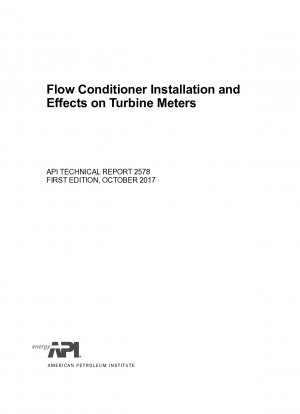API TR 2578-2017
Flow Conditioner Installation and Effects on Turbine Meters (FIRST EDITION)
- Standard No.
- API TR 2578-2017
- Release Date
- 2017
- Published By
- API - American Petroleum Institute
- Latest
- API TR 2578-2017
- Scope
- API MPMS Chapter 5.3 and parts of API MPMS Chapter 6 cover the installation requirements and performance characteristics of turbine meters in liquid hydrocarbon service. This research work provides data that should be considered for future incorporation into these standards. Phase I of this flow conditioning task force was performed on water prior to 2009. As part of Phase I@ an addendum was included in API MPMS Chapter 5@ Section 5.3.5.3 and Appendix A.1@ that recommended the need for flow conditioning rather than straight pipe of any length. Phase II was intended to prove or disprove whether the results on water would translate to light hydrocarbons@ higher viscosities@ larger line and strainer sizes@ and different Reynolds numbers. Phase II of the flow conditioning project tested several sizes and types of turbine meters@ strainers@ and piping arrangements with various types and arrangements of commercially available flow conditioners. This was carried out on a range of petroleum liquids to try to determine which flow conditioner arrangements provide adequate turbine meter accuracy for liquid hydrocarbon applications. Previous work by the Ad Hoc Flow Conditioning Task Force determined that meter performance@ as reflected by meter factor deviation@ repeatability@ and reproducibility@ was sensitive to flow profile effects caused by obstructions in strainer baskets@ as well as strainer basket movement. Phase II testing continued with obstructions similar to those in Phase I (water testing)@ but ??finger left?? (D) and ??finger right?? (E) obstructions were eliminated part way through Phase II testing@ as they were found to cause minimal change to meter factor deviation. On either configuration (above)@ there were five different strainer obstructions: a) half-moon left b) half-moon right c) full moon d) ??finger left?? e) ??finger right?? Figure 2 shows the devices utilized to replicate installation effects or varying strainer blockages. Obstructions A and B were constructed having approximately half the strainer discharge bore. Obstruction C was constructed having close to the entire strainer discharge bore. The dimensions of obstructions D and E are approximately 1?? x 4?? regardless of strainer discharge bore. Strainers used in testing had nozzle diameters of 4??@ 6??@ and 8??. Each separate test consisted of runs 1?C7 (as listed below). Each of these seven runs consisted of six meter provings of five runs each. Each test was conducted at 53 % and 80 % of the maximum BPH rate of each size meter. The strainer@ flow conditioning section@ and meter remained constant while five different obstructions were sequentially installed in the strainer basket: 1. no obstruction 2. obstruction A (A-type in Figure 3 shows position) 3. obstruction B (B-type in Figures 3 and 4 shows position) 4. obstruction C (C-type in Figure 3 shows position) 5. obstruction D 6. obstruction E 7. no obstruction Approximately 50 total tests were completed to provide the data that is used in this technical report.
API TR 2578-2017 history
- 2017 API TR 2578-2017 Flow Conditioner Installation and Effects on Turbine Meters (FIRST EDITION)
